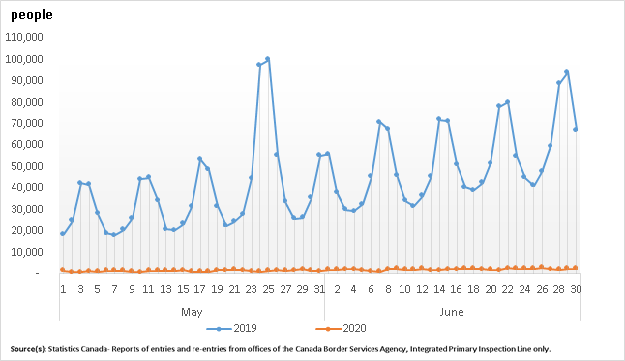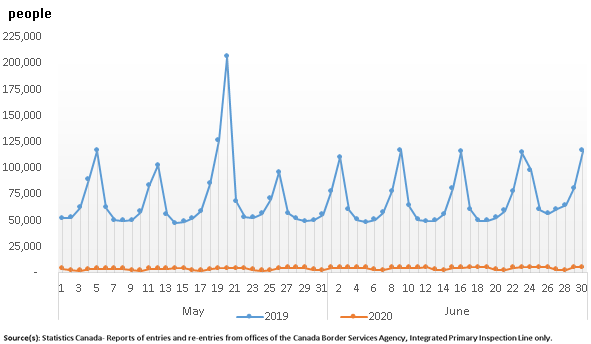Leading indicator of cross-border traveller volume, June 2020 (final)
Archived Content
Information identified as archived is provided for reference, research or recordkeeping purposes. It is not subject to the Government of Canada Web Standards and has not been altered or updated since it was archived. Please "contact us" to request a format other than those available.
Released: 2020-07-14
Highlights
June 2020 was the third consecutive full month of restrictions on non-essential travel at the Canadian-US border and the number of crossings by automobiles remained almost at a standstill.
US residents made 96% fewer trips to Canada by automobile through Integrated Primary Inspection Line (IPIL) land ports compared with 12 months before.
Similarly, the number of Canadian residents returning from the United States by automobiles through the same ports fell by nearly 94% from June 2019.
Travel restrictions continue
Since the enactment of the first 30-day restriction on all non-essential travel across the Canada-US border on March 21, 2020, the closure has been extended three times, for 30 days each time.
On June 16, 2020, the Canadian and American governments extended the closure of the border for another 30 days (until July 21) to slow the spread of the novel coronavirus (COVID-19).
Arrivals from the United States down significantly
In June 2020, 64,200 US residents entered Canada in US-licensed automobiles through 111 land ports equipped with the automated IPIL, down 96% from 1.6 million in June 2019.
The largest year-over-year absolute declines in US arrivals by automobile were recorded at IPIL ports in Canada's three largest provinces of Ontario, Quebec and British Columbia, which together accounted for about 75% of the total decline.
Returning Canadians down significantly
There were 136,400 Canadian residents who returned to Canada in Canadian-licensed automobiles through the 111 IPIL ports in June 2020—94% fewer than the 2.1 million recorded in June of the previous year.
The largest year-over-year absolute declines in the number of Canadians returning from the United States by car were recorded in Ontario (from 1.0 million to 93,100), British Columbia (from 479,600 to 12,600) and Quebec (295,200 to 8,800).
Note to readers
Data indicating cross-border travel by automobile through 111 land ports equipped with the automated Integrated Primary Inspection Line (IPIL) system are now available by the traveller's state or province of residence and by the province of entry into Canada. A traveller's state or province of residence is based on the licence plate of the automobile used to enter Canada.
The Canada Border Services Agency (CBSA) uses various data sources to collect information on travellers entering the country. One of the CBSA's sources, the IPIL system, yields data in an electronic format that requires less processing. These data account for the largest share of travellers entering Canada by automobile.
The IPIL data exclude automobile travellers who cross the Canada-US border using a NEXUS card and at ports that are not equipped with the IPIL system. These counts also exclude US travellers entering Canada in automobiles with Canadian licence plates and Canadian travellers returning to the country in automobiles with US licence plates.
As such, the IPIL data only represent a subset of Canadian and US residents entering Canada by automobile. In 2019 for example, the 111 IPIL ports covered by this indicator captured approximately 80% of cross-border automobile traffic between Canada and the United States.
Contact information
For more information, or to enquire about the concepts, methods or data quality of this release, contact us (toll-free 1-800-263-1136; 514-283-8300; STATCAN.infostats-infostats.STATCAN@canada.ca) or Media Relations (613-951-4636; STATCAN.mediahotline-ligneinfomedias.STATCAN@canada.ca).
- Date modified:



